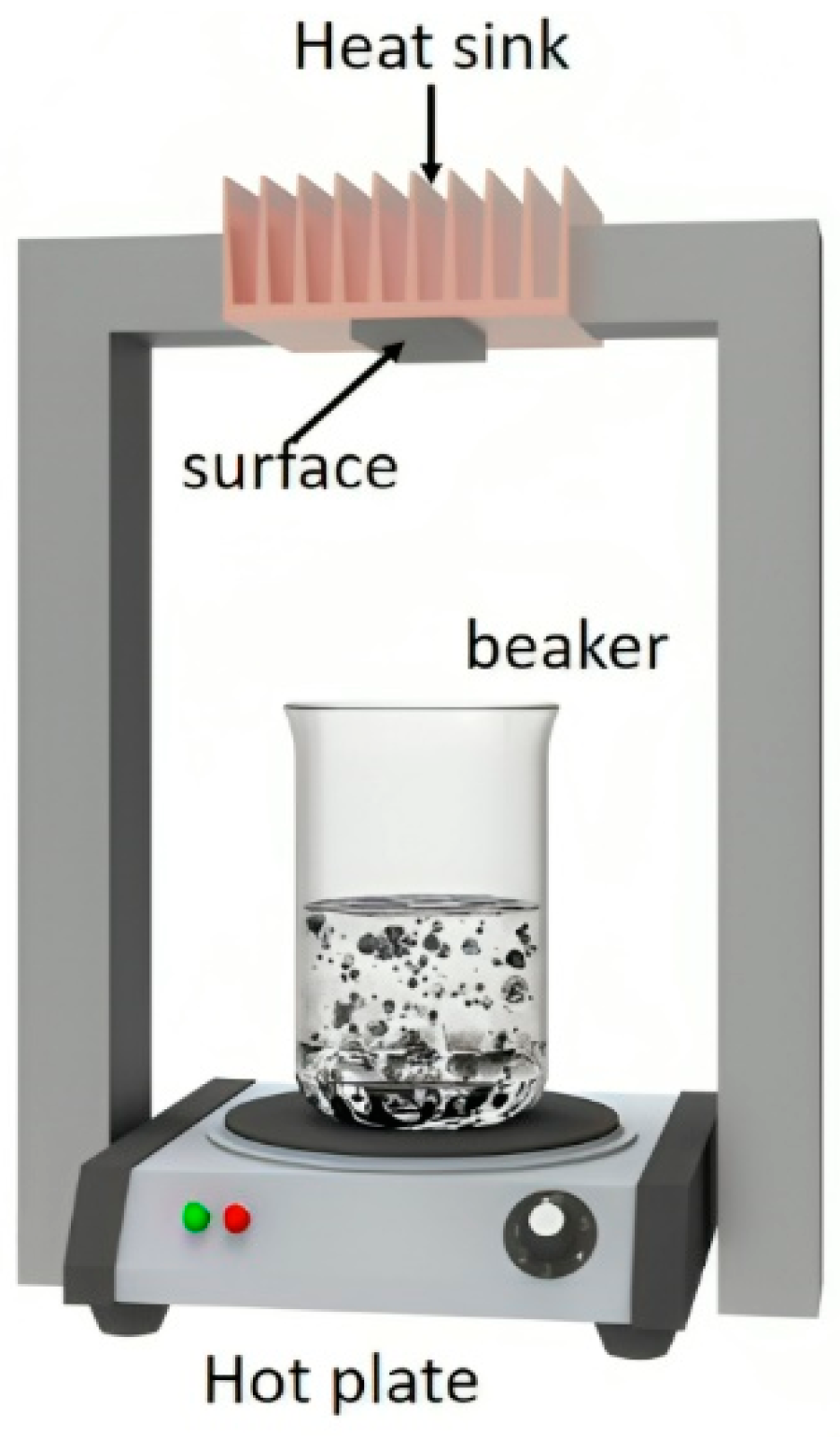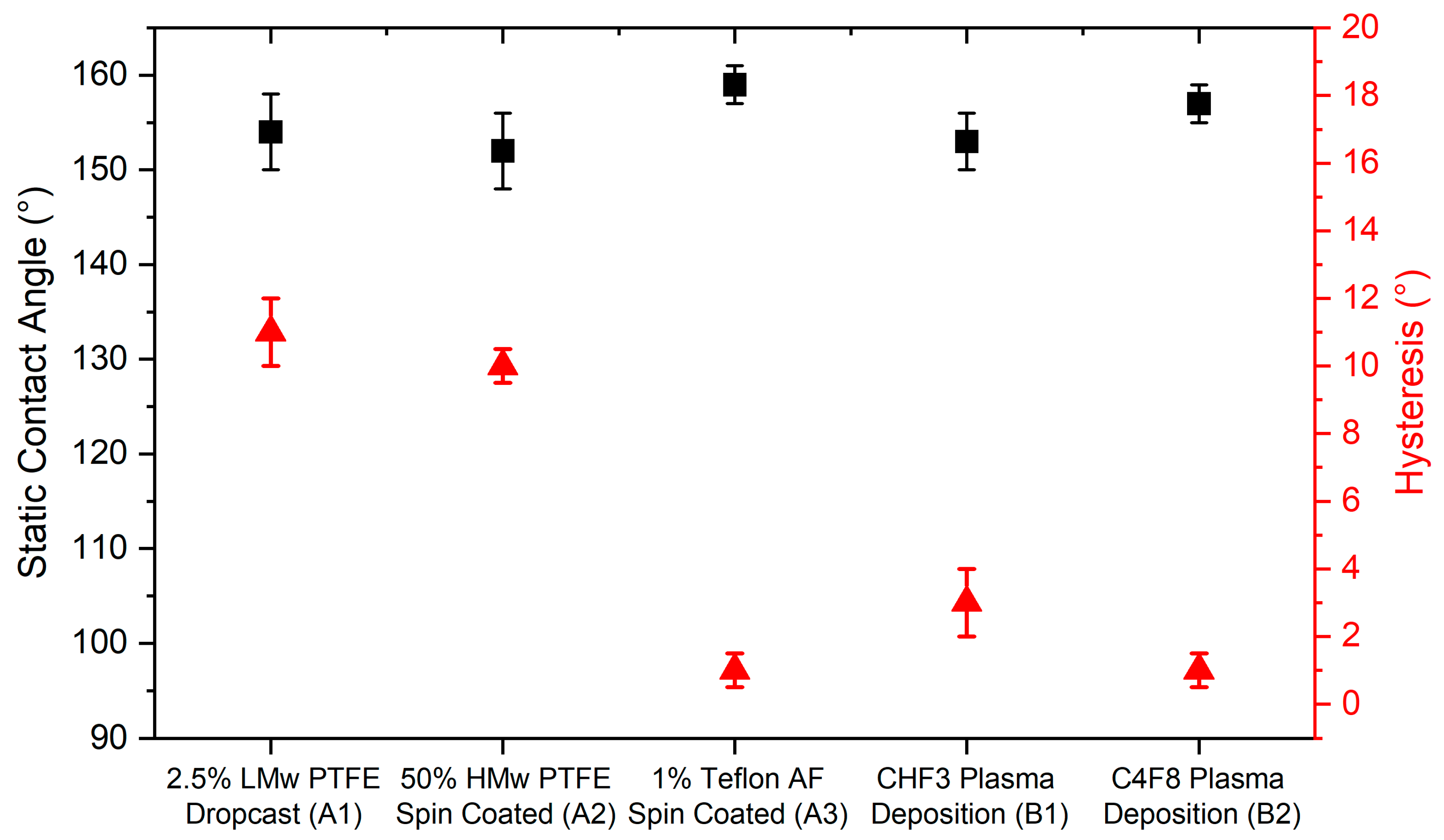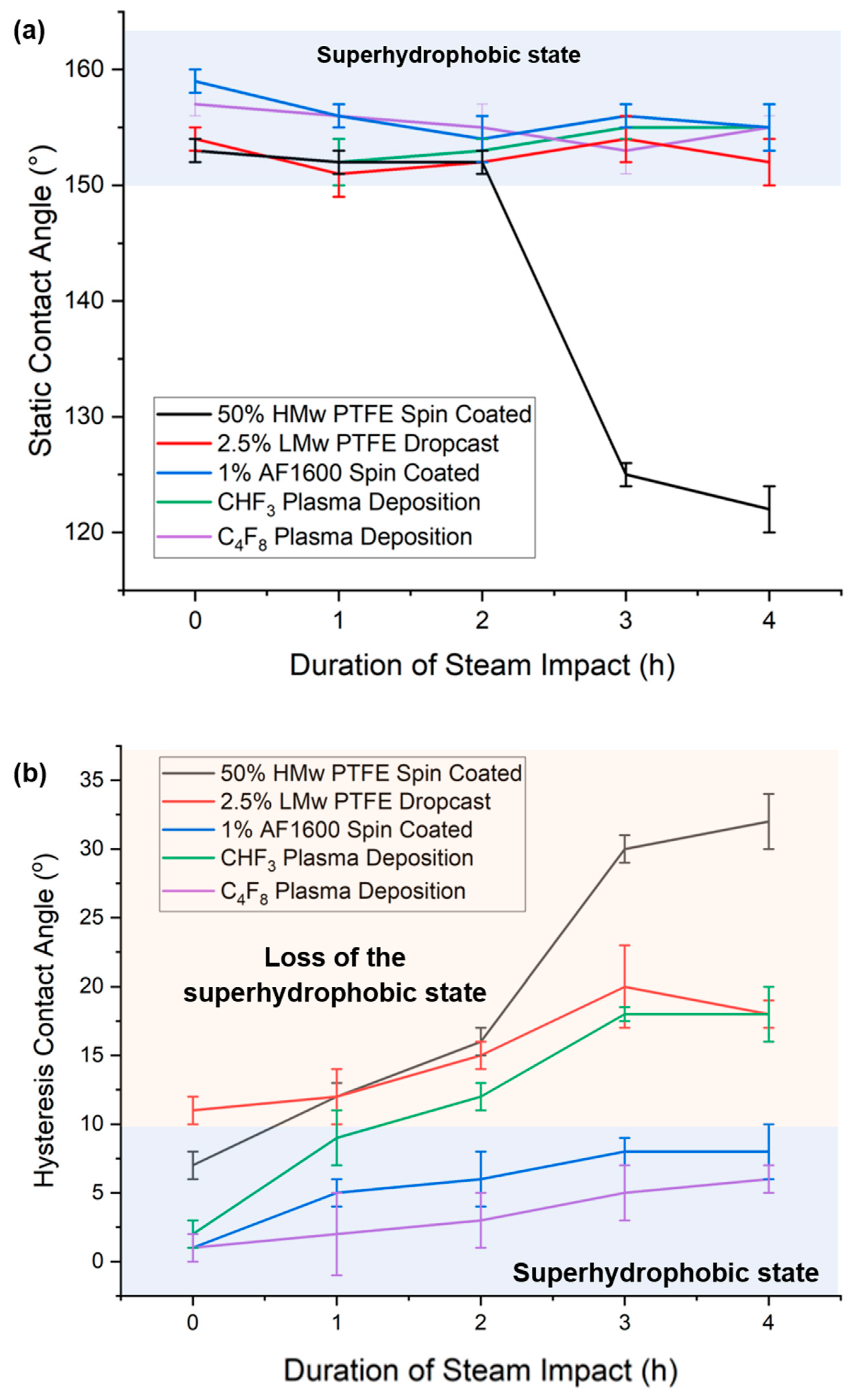Durable Superhydrophobic Aluminum Surfaces against Immersion and Hot Steam Impact: A Comparative Evaluation of Different Hydrophobization Methods and Coatings
Abstract
:1. Introduction
2. Materials and Methods
2.1. Materials
2.2. Aluminum Micro-Nanotexturing
2.3. Hydrophobization
2.4. Superhydrophobic Surface Characterization
3. Results and Discussion
3.1. Micro-Nanotopography and Coating Characterization
3.2. Wetting Properties Characterization
3.3. Durability of the Superhydrophobic Coatings during Immersion in Hot Water
3.4. Durability of the Superhydrophobic Coatings over Steam
4. Conclusions
Author Contributions
Funding
Institutional Review Board Statement
Informed Consent Statement
Data Availability Statement
Conflicts of Interest
References
- Ellinas, K.; Dimitrakellis, P.; Sarkiris, P.; Gogolides, E. A Review of Fabrication Methods, Properties and Applications of Superhydrophobic Metals. Processes 2021, 9, 666. [Google Scholar] [CrossRef]
- Sarkiris, P.; Ellinas, K.; Gkiolas, D.; Mathioulakis, D.; Gogolides, E. Motion of Drops with Different Viscosities on Micro-Nanotextured Surfaces of Varying Topography and Wetting Properties. Adv. Funct. Mater. 2019, 29, 1902905. [Google Scholar] [CrossRef]
- Mei, C.C.; Guo, X.Y. Numerical Study of Laminar Boundary-Layer Flows over a Superhydrophobic Plate. Phys. Fluids 2018, 30, 072002. [Google Scholar] [CrossRef]
- Costantini, R.; Mollicone, J.-P.; Battista, F. Drag Reduction Induced by Superhydrophobic Surfaces in Turbulent Pipe Flow. Phys. Fluids 2018, 30, 025102. [Google Scholar] [CrossRef]
- Tarquini, S.; Antonini, C.; Amirfazli, A.; Marengo, M.; Palacios, J. Investigation of Ice Shedding Properties of Superhydrophobic Coatings on Helicopter Blades. Cold Reg. Sci. Technol. 2014, 100, 50–58. [Google Scholar] [CrossRef]
- Bahgat Radwan, A.; Abdullah, A.M.; Alnuaimi, N.A. Recent Advances in Corrosion Resistant Superhydrophobic Coatings. Corros. Rev. 2018, 36, 127–153. [Google Scholar] [CrossRef]
- Parin, R.; Martucci, A.; Sturaro, M.; Bortolin, S.; Bersani, M.; Carraro, F.; Del Col, D. Nano-Structured Aluminum Surfaces for Dropwise Condensation. Surf. Coat. Technol. 2018, 348, 1–12. [Google Scholar] [CrossRef]
- Chen, C.; Yang, S.; Liu, L.; Xie, H.; Liu, H.; Zhu, L.; Xu, X. A Green One-Step Fabrication of Superhydrophobic Metallic Surfaces of Aluminum and Zinc. J. Alloys Compd. 2017, 711, 506–513. [Google Scholar] [CrossRef]
- Liu, L.; Zhao, J.; Zhang, Y.Y.; Zhao, F.; Zhang, Y.Y. Fabrication of Superhydrophobic Surface by Hierarchical Growth of Lotus-Leaf-like Boehmite on Aluminum Foil. J. Colloid. Interface Sci. 2011, 358, 277–283. [Google Scholar] [CrossRef]
- Su, W.; Lu, X.; Shu, Y.; Liu, X.; Gao, W.; Yao, J.; Niu, Z.; Xie, Y. Robust, Superhydrophobic Aluminum Fins with Excellent Mechanical Durability and Self-Cleaning Ability. Micromachines 2023, 14, 704. [Google Scholar] [CrossRef]
- Semiletov, A.M.; Chirkunov, A.A.; Grafov, O.Y.; Kuznetsov, Y.I. Stability of Supehydrophobic Layers Formed by Organic Acids on the Surface of Aluminum Alloy 6063. Coatings 2022, 12, 1468. [Google Scholar] [CrossRef]
- Gou, Y.; Zhou, J.; Li, P.; Meng, X.; Huang, S.; Zhang, Y. Preparation of 2024-T351 Aluminum Alloy Super-Hydrophobic Surface by Laser Shock/Etching. Appl. Phys. A Mater. Sci. Process. 2022, 128, 658. [Google Scholar] [CrossRef]
- Kuang, M.; Yang, X.; Huang, Y.; Xu, K.; Ye, X. Preparation of Durable Superhydrophobic Composite Surface. Mater. Today Commun. 2023, 36, 106618. [Google Scholar] [CrossRef]
- Misiiuk, K.; Lowrey, S.; Blaikie, R.; Juras, J.; Sommers, A. Study of Micro- and Nanopatterned Aluminum Surfaces Using Different Microfabrication Processes for Water Management. Langmuir 2022, 38, 1386–1397. [Google Scholar] [CrossRef]
- Yang, Z.; He, X.; Chang, J.; Bai, X.; Cao, P.; Yuan, C. Fabrication of Biomimetic Slippery Liquid-Infused Porous Surface on 5086 Aluminum Alloy with Excellent Antifouling Performance. Surf. Interface Anal. 2021, 53, 147–155. [Google Scholar] [CrossRef]
- Li, X.; Liu, X. Study on Corrosion Resistance of Superhydrophobic Film Prepared on the Surface of 2024 Aluminum Alloy. Int. J. Electrochem. Sci. 2022, 17, 220242. [Google Scholar] [CrossRef]
- Qiu, X.; Wang, Y. Preparation of Superhydrophobic Composite Coating on 2024 Aluminum Alloy and Its Stability and Corrosion Resistance. Int. J. Electrochem. Sci. 2023, 18, 100088. [Google Scholar] [CrossRef]
- Zhang, Q.; Huang, Z.; Shao, R.; Chen, J.; Zang, D. Controlled Self-Cleaning Aluminum Surfaces Mediated by Anodic Aluminum Oxide. Microsc. Res. Tech. 2023, 86, 694–700. [Google Scholar] [CrossRef]
- Zhu, T.; Yuan, Y.; Yu, Q.; Xiang, H.; Liu, G.; Dai, X.; Liao, R. Enhanced Corrosion Resistance of Slippery Liquid Infused Porous Aluminum Surfaces Prepared by Anodizing in Simulated Marine Atmosphere. Mater. Chem. Phys. 2023, 306, 128073. [Google Scholar] [CrossRef]
- Liu, Y.; Yuan, G.; Guo, C.; Ngo, C.V.; Li, W. Femtosecond Laser Fabrication and Chemical Coating of Anti-Corrosion Ethylene-Glycol Repellent Aluminum Surfaces. Mater. Lett. 2022, 323, 132562. [Google Scholar] [CrossRef]
- Choi, I.S.; Jang, W.K.; Seo, Y.H.; Kim, B.H. Fabrication of Super-Hydrophobic Nanocomposite Metal Surface for Anti-Frosting. In Proceedings of the World Congress on Recent Advances in Nanotechnology, London, UK, 8–10 April 2024. [Google Scholar] [CrossRef]
- Peng, J.; Geng, H.; Xu, F.; Zhang, M.; Ye, P.; Jiang, Y.; Wang, H. Endowing Versatility and Superamphiphobicity to Composite Coating via a Bioinspired Strategy. Chem. Eng. J. 2023, 455, 140772. [Google Scholar] [CrossRef]
- Liu, Z.; Zhang, C.; Zhang, X.; Wang, C.; Liu, F.; Yuan, R.; Wang, H. Durable Superhydrophobic PVDF/FEVE/GO@TiO2 Composite Coating with Excellent Anti-Scaling and UV Resistance Properties. Chem. Eng. J. 2021, 411, 128632. [Google Scholar] [CrossRef]
- Liu, Z.; Zhang, C.; Jing, J.; Zhang, X.; Wang, C.; Liu, F.; Jiang, M.; Wang, H. Bristle Worm Inspired Ultra-Durable Superhydrophobic Coating with Repairable Microstructures and Anti-Corrosion/Scaling Properties. Chem. Eng. J. 2022, 436, 135273. [Google Scholar] [CrossRef]
- Liu, Z.; Ren, L.; Zhang, B.; Jing, J.; Zhang, X.; Li, M.; Fu, Y.; Wang, H. Eco-Friendly Waterborne Superhydrophobic/Superoleophilic FEVE Composite Coating with Prolonged Mechanochemical and Anti-Scaling Properties. Chem. Eng. J. 2023, 451, 138693. [Google Scholar] [CrossRef]
- Zhang, Y.; Ge, D.; Yang, S. Spray-Coating of Superhydrophobic Aluminum Alloys with Enhanced Mechanical Robustness. J. Colloid Interface Sci. 2014, 423, 101–107. [Google Scholar] [CrossRef] [PubMed]
- Wang, S.; Zhang, W.; Yu, X.; Liang, C.; Zhang, Y. Sprayable Superhydrophobic Nano-Chains Coating with Continuous Self-Jumping of Dew and Melting Frost. Sci. Rep. 2017, 7, 40300. [Google Scholar] [CrossRef] [PubMed]
- Wang, N.; Xiong, D. Superhydrophobic Membranes on Metal Substrate and Their Corrosion Protection in Different Corrosive Media. Appl. Surf. Sci. 2014, 305, 603–608. [Google Scholar] [CrossRef]
- Lakshmi, R.V.; Bharathidasan, T.; Bera, P.; Basu, B.J. Surface & Coatings Technology Fabrication of Superhydrophobic and Oleophobic Sol-Gel Nanocomposite Coating. Surf. Coat. Technol. 2012, 206, 3888–3894. [Google Scholar] [CrossRef]
- Zhang, X.; Yuan, J.; Xu, L.; Tian, Z.; Wang, J. Pseudo-Online Optimization of Condenser Pressure for the Cold-End System with Variable Speed Pumps. Appl. Therm. Eng. 2017, 126, 339–349. [Google Scholar] [CrossRef]
- Chuang, C.C.; Sue, D.C. Performance Effects of Combined Cycle Power Plant with Variable Condenser Pressure and Loading. Energy 2005, 30, 1793–1801. [Google Scholar] [CrossRef]
- Sarkiris, P.; Constantoudis, V.; Ellinas, K.; Lam, C.W.E.; Milionis, A.; Anagnostopoulos, J.; Poulikakos, D.; Gogolides, E. Topography Optimization for Sustainable Dropwise Condensation: The Critical Role of Correlation Length. Adv. Funct. Mater. 2024, 34, 2306756. [Google Scholar] [CrossRef]
- Jafari, R.; Farzaneh, M. Fabrication of Superhydrophobic Nanostructured Surface on Aluminum Alloy. Appl. Phys. A 2011, 102, 195–199. [Google Scholar] [CrossRef]
- Owens, D.K.; Wendt, R.C. Estimation of the Surface Free Energy of Polymers. J. Appl. Polym. Sci. 1969, 13, 1741–1747. [Google Scholar] [CrossRef]
- Sharma, C.S.; Combe, J.; Giger, M.; Emmerich, T.; Poulikakos, D. Growth Rates and Spontaneous Navigation of Condensate Droplets through Randomly Structured Textures. ACS Nano 2017, 11, 1673–1682. [Google Scholar] [CrossRef] [PubMed]
- Zhang, B.; Zeng, Y.; Wang, J.; Sun, Y.; Zhang, J.; Li, Y. Superamphiphobic Aluminum Alloy with Low Sliding Angles and Acid-Alkali Liquids Repellency. Mater. Des. 2020, 188, 108479. [Google Scholar] [CrossRef]
- Lee, H.J.; Motomura, H.; Tachibana, K. Observations of Silicon Surfaces Exposed to Inductively Coupled CHF3 and C4F8/H2 Plasmas Using Fourier Transform Infrared Ellipsometry. Jpn. J. Appl. Phys. 1998, 37, 4522–4526. [Google Scholar] [CrossRef]
- Bayiati, P.; Tserepi, A.; Petrou, P.S.; Misiakos, K.; Kakabakos, S.E.; Gogolides, E.; Cardinaud, C. Biofluid Transport on Hydrophobic Plasma-Deposited Fluorocarbon Films. Microelectron. Eng. 2007, 84, 1677–1680. [Google Scholar] [CrossRef]
- Stewart, R.J.; Ransom, T.C.; Hlady, V. Natural Underwater Adhesives. J. Polym. Sci. B Polym. Phys. 2011, 49, 757. [Google Scholar] [CrossRef]
- Pujari, S.P.; Spruijt, E.; Cohen Stuart, M.A.; Van Rijn, C.J.M.; Paulusse, J.M.J.; Zuilhof, H. Ultralow Adhesion and Friction of Fluoro-Hydro Alkyne-Derived Self-Assembled Monolayers on H-Terminated Si(111). Langmuir 2012, 28, 17690–17700. [Google Scholar] [CrossRef]
- Kwon, J.-S.; Thakur, R.; Wereley, S.T.; Schall, J.D.; Mikulski, P.T.; Ryan, K.E.; Keating, P.L.; Knippenberg, M.T.; Harrison, J.A.; Alan, T.; et al. Rose Petal Effect. In Encyclopedia of Nanotechnology; Springer: Berlin/Heidelberg, Germany, 2012; pp. 2265–2272. [Google Scholar] [CrossRef]
- Ellinas, K.; Pujari, S.P.; Dragatogiannis, D.A.; Charitidis, C.A.; Tserepi, A.; Zuilhof, H.; Gogolides, E. Plasma Micro-Nanotextured, Scratch, Water and Hexadecane Resistant, Superhydrophobic, and Superamphiphobic Polymeric Surfaces with Perfluorinated Monolayers. ACS Appl. Mater. Interfaces 2014, 6, 6510–6524. [Google Scholar] [CrossRef]
- Tselepi, V.; Sarkiris, P.; Nioras, D.; Tsouko, E.; Sarris, D.; Gogolides, E.; Ellinas, K. Functional Surfaces for Passive Fungal Proliferation Control: Effect of Surface Micro- and Nanotopography, Material, and Wetting Properties. ACS Appl. Bio Mater. 2024, 7, 4510–4518. [Google Scholar] [CrossRef] [PubMed]
- Deák, Á.; Janovák, L.; Tallósy, S.P.; Godič-Torkar, K.; Abram, A.; Dékány, I.; Sebők, D.; Bohinc, K. Synthesis of Self-Cleaning and Photoreactive Spherical Layered Double Oxide/Polymer Composite Thin Layers: Biofouling and Inactivation of Bacteria. Appl. Clay Sci. 2022, 228, 106587. [Google Scholar] [CrossRef]







| 2.5% Low Mw PTFE Drop Casting Used in Surface A1 | 50% High Mw PTFE Spin Coating Used in Surface A2 | 1% w/v Teflon AF 1600 Spin Coating Used in Surface A3 | CHF3 Plasma Deposition Used in Surface B1 | C4F8 Plasma Deposition Used in Surface B2 | |
|---|---|---|---|---|---|
| CA (°): | 106 ± 1° | 109 ± 1° | 123 ± 1° | 105 ± 2° | 108 ± 2° |
| Hysteresis (°): | >20° | >20° | ~20° | >20° | >20° |
| Surface energy [mN/m] | 26.91 ± 0.12 | 27.34 ± 0.3 | 15.34 ± 0.3 | 23.69 ± 0.2 | 22.75 ± 0.2 |
| Coating thickness on flat Si | 2–3 μm | 1–2 μm | ~100 nm | 60 nm | 30 nm |
Disclaimer/Publisher’s Note: The statements, opinions and data contained in all publications are solely those of the individual author(s) and contributor(s) and not of MDPI and/or the editor(s). MDPI and/or the editor(s) disclaim responsibility for any injury to people or property resulting from any ideas, methods, instructions or products referred to in the content. |
© 2024 by the authors. Licensee MDPI, Basel, Switzerland. This article is an open access article distributed under the terms and conditions of the Creative Commons Attribution (CC BY) license (https://creativecommons.org/licenses/by/4.0/).
Share and Cite
Sarkiris, P.; Ellinas, K.; Gogolides, E. Durable Superhydrophobic Aluminum Surfaces against Immersion and Hot Steam Impact: A Comparative Evaluation of Different Hydrophobization Methods and Coatings. Coatings 2024, 14, 908. https://doi.org/10.3390/coatings14070908
Sarkiris P, Ellinas K, Gogolides E. Durable Superhydrophobic Aluminum Surfaces against Immersion and Hot Steam Impact: A Comparative Evaluation of Different Hydrophobization Methods and Coatings. Coatings. 2024; 14(7):908. https://doi.org/10.3390/coatings14070908
Chicago/Turabian StyleSarkiris, Panagiotis, Kosmas Ellinas, and Evangelos Gogolides. 2024. "Durable Superhydrophobic Aluminum Surfaces against Immersion and Hot Steam Impact: A Comparative Evaluation of Different Hydrophobization Methods and Coatings" Coatings 14, no. 7: 908. https://doi.org/10.3390/coatings14070908






